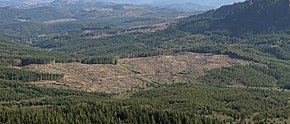
Back إزالة الأشجار Arabic Mýcení Czech Rãbiskò CSB Kahlschlag German Αποψιλωτική υλοτομία Greek Forhakado Esperanto Tala rasa Spanish Lageraie Estonian پاکتراشی Persian Avohakkuu Finnish


Clearcutting, clearfelling or clearcut logging is a forestry/logging practice in which most or all trees in an area are uniformly cut down. Along with shelterwood and seed tree harvests, it is used by foresters to create certain types of forest ecosystems and to promote select species[1] that require an abundance of sunlight or grow in large, even-age stands.[2] Logging companies and forest-worker unions in some countries support the practice for scientific, safety and economic reasons, while detractors consider it a form of deforestation that destroys natural habitats[3] and contributes to climate change.[4] Environmentalists, traditional owners, local residents and others have regularly campaigned against clearcutting, including through the use of blockades and nonviolent direct action.[5]
Clearcutting is the most common and economically profitable method of logging. However, it also may create detrimental side effects, such as the loss of topsoil, the costs of which are intensely debated by economic, environmental and other interests. In addition to the purpose of harvesting wood, clearcutting is used to create land for farming.[6] Ultimately, the effects of clearcutting on the land will depend on how well or poorly the forest is managed,[7] and whether it is converted to non-forest land uses after clearcuts.[8]
While deforestation of both temperate and tropical forests through clearcutting has received considerable media attention in recent years, the other large forests of the world, such as the taiga, also known as boreal forests, are also under threat of rapid development. In Russia, North America and Scandinavia, creating protected areas and granting long-term leases to tend and regenerate trees—thus maximizing future harvests—are among the means used to limit the harmful effects of clearcutting.[9] Long-term studies of clearcut forests, such as studies of the Pasoh Rainforest in Malaysia, are also important in providing insights into the conservation of forest resources worldwide.[10]
- ^ Merivale, William (2013-08-14). "Budget for a €2,500/ha reforestation cost after clearfelling mature forest". FarmIreland.ie. Retrieved 2018-05-12.
- ^ Cite error: The named reference
Dovetailwas invoked but never defined (see the help page). - ^ U.S. Environmental Protection Agency, Washington, DC (1992). "Clear cut." Terms of Environment: Glossary, Abbreviations and Acronyms. p. 6. Document no. EPA-175-B-92-001. Accessed 2011-10-12.
- ^ Center for Biological Diversity, Tucson, AZ. "Clearcutting and Climate Change." Archived 2018-06-26 at the Wayback Machine Accessed 2011-10-12.
- ^ McIntyre, Iain (2020-11-04). "Environmental Blockading in Australia and Around the World – Timeline 1974–1997". The Commons Social Change Library. Retrieved 2023-07-07.
- ^ "Global Environmental Governance Project: Forests". Archived from the original on 2012-11-18. Retrieved 2012-11-08.
- ^ Rodney J. Keenan, & J.P. (Hamish) Kimmins (1993)."The ecological effects of clear-cutting" Environmental Reviews, 1(2), 121–144. Retrieved September 16, 2020.
- ^ FAO (2016). "State of the World's Forests 2016"
- ^ Kunganavolok (June 25, 1998). "Taiga! taiga! burning bright." The Economist. Retrieved: 2013-08-06.
- ^ Khan, Madeline (February 9, 2004). "Clear cut forests in Malaysia offer lessons for logging worldwide." The Varsity, University of Toronto. Retrieved: 2013-08-06.
© MMXXIII Rich X Search. We shall prevail. All rights reserved. Rich X Search